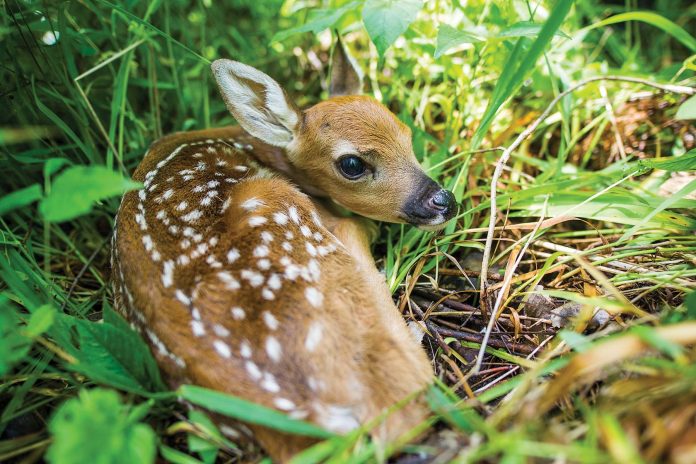I’m seeing a lot of does with their spotted fawns following closely behind them. A few times while out in the field this time of year, I’ve come across bedded fawns, seemingly all alone with no doe in sight. As you head out to find your adventure in the woods and fields around our county, you may even come across one yourself. Right now is the peak time for fawns to be born, so I urge you NOT to touch them. There is a better than average chance it’s right where it’s supposed to be.
“If you come across a fawn lying still and quiet and you don’t see mom around, that’s a good sign,” according to Robert Ryan of the Whitetail Institute of North America. “That fawn is doing exactly what it’s supposed to do to keep safe.”
Does spend most of the day away from their fawns while they forage for food. They bed down their fawns, to lie still in brush or tall grass, keeping quiet until their mothers return. Although fawns can walk from birth, they need a few more weeks to grow up and strengthen their legs before they can keep up with their mothers and develop enough speed to escape from danger. Their spotted, camouflaged coats and lack of scent are their best defenses in the first few weeks of life.
It’s very rare that any unaccompanied fawns have been abandoned. So, if you find a fawn lying alone, unless the fawn appears sick or injured, leave the little fellas alone. Just walk away from the area and don’t go near that spot again. The mother isn’t bound to return if people are present. Please, don’t touch the fawn or bring out the kids or friends to look at it. Doing something like that could potentially endanger the fawn by giving away its location to a predator, and its mother won’t return to nurse the fawn until she’s sure the coast is clear.
If you are genuinely concerned, come back the next day and check on it from a distance. It’s not likely it’ll be there as the doe will return periodically to feed and move it to a new location. Now, if a fawn is in an unsafe location, such as near the side of the road, it’s okay to move it back from the road several yards. The doe will be able find her fawn, although you should avoid touching the fawn unless absolutely necessary. If the fawn is still there the next day or appears visibly sick or lame, call the Florida Wildlife Commission and they will either respond or give you the contact information for a licensed rehab facility.
I surely thank you for all of your input and as always, if you have any feedback, give me a shout at [email protected]. God Bless and Good Hunting!

